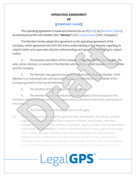Name Affidavits: What You Need to Know
If you are trying to obtain a name change, such as through an adoption or marriage, you may need to file a name affidavit. This document is used for...
5 min read
LegalGPS : Jul. 24, 2024
Hello, entrepreneur friends! The world of legal documentation can undoubtedly be a winding maze if you're not regularly engaging with such material. Today, we'll toss some light on a particularly critical document – the Affidavit of Ownership.


Affidavit of Ownership Template
Secure your ownership claims with our Affidavit of Ownership Template. Easily customize it to legally affirm your property rights. Download now!
Trusted by 1,000+ businesses to safeguard their LLCs.
An Affidavit of Ownership is a formal, legally binding document asserting that you own a certain property. This property could be a business, a piece of land, or even a vehicle. It's a handy little document that serves as proof of your rightful ownership.
It's not a mere receipt or an invoice; it's an affidavit. That takes it into the serious zone because falsehoods made in affidavits can bring about legal repercussions. But don't worry, we're here to ensure you navigate around any potential pitfalls!
There are many instances where you might need an Affidavit of Ownership. Here are a few common scenarios:
When selling your business or real estate property, providing an Affidavit of Ownership is not just a standard procedure; it is a crucial step in ensuring a smooth and legally sound transaction. This document serves as concrete proof of your ownership rights, giving potential buyers the confidence and assurance they need to proceed with the deal.
By officially declaring your ownership in an Affidavit, you are not only protecting your interests but also establishing a solid foundation for the transfer of property or business ownership. So, whether you are selling a thriving business or a valuable piece of real estate, having this essential document in place is a non-negotiable step in the process.
In a worst-case scenario, you might find yourself needing to prove your ownership against a legal challenge. This could arise in situations where there is a dispute over the rightful ownership of a property, whether it be a business, real estate, or any other valuable asset. It is crucial to have an Affidavit of Ownership in place to provide concrete evidence of your ownership rights and to defend against any legal challenges that may arise. By having this document prepared and ready, you can protect your interests and ensure that you have the necessary documentation to support your claim in case of any disagreements or disputes.
Establishing ownership of the property for government records is a crucial step in ensuring that your ownership rights are officially recognized and recorded by the relevant authorities. By submitting an Affidavit of Ownership to the government, you are not only providing concrete evidence of your ownership but also creating a legal record that can be referenced in the future if needed.
This documentation is essential for maintaining transparency and accuracy in property ownership records, which can be especially important in cases of inheritance, property disputes, or other legal matters. Additionally, having your ownership officially recorded by the government can help protect your interests and prevent any potential challenges to your ownership rights in the future.
In case of loss or theft, having an Affidavit of Ownership prepared and readily available can be a lifesaver. In the unfortunate event that your property is stolen or goes missing, this document serves as concrete evidence of your ownership rights. By promptly presenting your Affidavit of Ownership to the relevant authorities, you can establish your claim and increase the chances of recovering your valuable asset.
Additionally, having this document in place can help expedite the process of filing reports with law enforcement agencies and insurance companies, ensuring a smoother and more efficient resolution to the situation. So, don't wait until it's too late – make sure you have your Affidavit of Ownership in place to protect yourself in case of any unforeseen circumstances.
Now that we know why this document is vital, let's go through its creation.
Comprehensive transactional guides and templates
The affidavit begins with a statement identifying you as the affiant (the person making the affidavit). You must give full, accurate details, including your legal name, current address, and age.
For example, if your name is John Smith and you live in New York, the statement would be: “I, John Smith, of XXXX Street, New York City, NY 10001 make this affirmation on (date).” If you have a common name or are concerned about identity theft, consider providing an additional identifier such as a birth date or Social Security number.
This step is the cornerstone of the Affidavit of Ownership. In this part, you explicitly state that you are the legal owner of the said property. Describe the property in as much detail as possible. If it's a vehicle, give the make, model, VIN number; if it's real estate, provide the address and any defining features.
For example, if you're claiming ownership of a house, describe its size, age, and condition; if it's jewelry or art, provide a description of the item.
It might read: "I, John Smith, am the legal owner of a one-story house located at 123 Main Street. The house has three bedrooms, two bathrooms and an attic."
"I claim ownership of one piece of jewelry: a gold bracelet with diamonds set on either side of an emerald."


Legal GPS Pro
Protect your business with our complete legal subscription service, designed by top startup attorneys.
Complete the statement by affirming that all the given information is accurate to the best of your knowledge. Here’s when the document becomes a legal instrument.
For example, if you’re selling a car, you could say something like, “I claim ownership of one car: a white Ford Focus with license plate number XYZ123.” Step 4: Execute the Documents Complete this step by signing and dating the document in front of a notary public or other legal representative.
You then sign the document, typically in the presence of a notary public. The notary also signs and stamps the affidavit, affirming your identity.
Get Your Affidavit of Ownership Template
with a Legal GPS Subscription
Now that you have some idea of how an affidavit works, let's go over some commonly made mistakes, so you're extra prepared.
Lack of detail: The more detail in your affidavit, the stronger the document. Include specifics, dates, and support it with additional documents if possible.
Incorrect information: Double-check, even triple-check all information. Inaccurate or incorrect information can render your affidavit void.
Incorrectly formed signatures: Make sure all signatures on your affidavit are properly executed. In some states, you'll need notarization for each signature; in others, you'll only need one notary to sign and witness the document. Incorrectly dated documents: Be sure to date your affidavit correctly; if necessary, consult with a legal professional before submitting it.
Failing to sign your affidavit: You must sign your document in front of the notary public, and the notary must also affix his or her seal. If there is no seal, then you should have a second witness sign and date the document.
The Affidavit of Ownership, as complex as it might seem, ultimately boils down to declaring (truthfully!) your ownership status on a paper and getting it legally endorsed. While it's a crucial document, it’s made a lot easier when you understand and follow each step meticulously.
Remember, in the world of entrepreneurship, the devil is in the detail. So, keep your facts straight, your details accurate, and your documents in order!

Affidavit of Ownership Template
Secure your ownership claims with our Affidavit of Ownership Template. Easily customize it to legally affirm your property rights. Download now!
Trusted by 1,000+ businesses to safeguard their LLCs.
The biggest question now is, "Do I need a business lawyer?” For most businesses and in most cases, you don't need a lawyer to start your business. Instead, many business owners rely on Legal GPS Pro to help with legal issues.
Legal GPS Pro is your All-In-One Legal Toolkit for Businesses. Developed by top startup attorneys, Pro gives you access to 100+ expertly crafted templates including operating agreements, NDAs, and service agreements, and an interactive platform. All designed to protect your company and set it up for lasting success.
Get Legal GPS's Affidavit of Ownership Template Now

Legal GPS Pro
Protect your business with our complete legal subscription service, designed by top startup attorneys.
|
Premium Template
Single-use Template |
Legal GPS Pro
Unlimited Access, Best Value |
|
|
| Choose Template | Learn More |
| Trusted by 1000+ businesses | |

If you are trying to obtain a name change, such as through an adoption or marriage, you may need to file a name affidavit. This document is used for...

An Affidavit of Ownership is a powerful legal tool used to verify ownership of real estate, vehicles, business interests, and other assets. While...

An Affidavit of Ownership is a legally binding document used to confirm a person’s ownership of an asset, such as real estate, a vehicle, business...